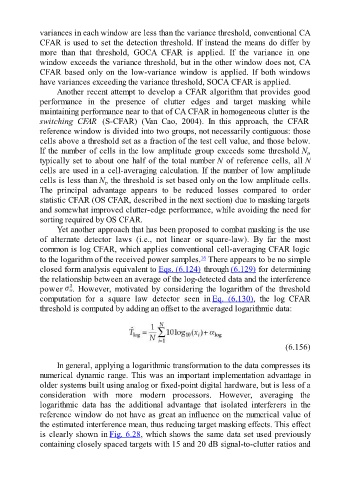Page 521 - Fundamentals of Radar Signal Processing
P. 521
variances in each window are less than the variance threshold, conventional CA
CFAR is used to set the detection threshold. If instead the means do differ by
more than that threshold, GOCA CFAR is applied. If the variance in one
window exceeds the variance threshold, but in the other window does not, CA
CFAR based only on the low-variance window is applied. If both windows
have variances exceeding the variance threshold, SOCA CFAR is applied.
Another recent attempt to develop a CFAR algorithm that provides good
performance in the presence of clutter edges and target masking while
maintaining performance near to that of CA CFAR in homogeneous clutter is the
switching CFAR (S-CFAR) (Van Cao, 2004). In this approach, the CFAR
reference window is divided into two groups, not necessarily contiguous: those
cells above a threshold set as a fraction of the test cell value, and those below.
If the number of cells in the low amplitude group exceeds some threshold N,
t
typically set to about one half of the total number N of reference cells, all N
cells are used in a cell-averaging calculation. If the number of low amplitude
cells is less than N, the threshold is set based only on the low amplitude cells.
t
The principal advantage appears to be reduced losses compared to order
statistic CFAR (OS CFAR, described in the next section) due to masking targets
and somewhat improved clutter-edge performance, while avoiding the need for
sorting required by OS CFAR.
Yet another approach that has been proposed to combat masking is the use
of alternate detector laws (i.e., not linear or square-law). By far the most
common is log CFAR, which applies conventional cell-averaging CFAR logic
16
to the logarithm of the received power samples. There appears to be no simple
closed form analysis equivalent to Eqs. (6.124) through (6.129) for determining
the relationship between an average of the log-detected data and the interference
power . However, motivated by considering the logarithm of the threshold
computation for a square law detector seen in Eq. (6.130), the log CFAR
threshold is computed by adding an offset to the averaged logarithmic data:
(6.156)
In general, applying a logarithmic transformation to the data compresses its
numerical dynamic range. This was an important implementation advantage in
older systems built using analog or fixed-point digital hardware, but is less of a
consideration with more modern processors. However, averaging the
logarithmic data has the additional advantage that isolated interferers in the
reference window do not have as great an influence on the numerical value of
the estimated interference mean, thus reducing target masking effects. This effect
is clearly shown in Fig. 6.28, which shows the same data set used previously
containing closely spaced targets with 15 and 20 dB signal-to-clutter ratios and

